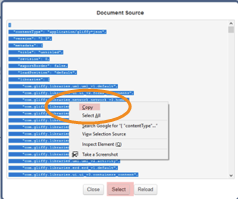Troubleshooting Gliffy Online
Click a heading to view details.
You edited an existing Gliffy diagram and when you try to save it, you get a spinning wheel and the diagram never saves. Attempting to export or print the diagram also fails. This occurs most often in the Chrome web browser and when your diagram includes a custom image that you imported.
When you add a custom image to Gliffy, a URL is added to the diagram source which points to the location of that custom image. If changes are made to Gliffy infrastructure, some custom images may cause existing diagrams to no longer function properly. This problem occurs most often when using Gliffy Online in the Chrome web browser because Chrome removes the CORS headers on redirection to the new URL.
To resolve the problem, try opening Gliffy Online in another supported web browser such as Firefox (see Minimum requirements). If this doesn’t work or you want to continue using Chrome, follow the steps below to resolve the problem.
Important: Be careful to only make the changes listed in these steps. Making any other changes to your diagram could cause problems with your diagram.
1.In Gliffy Online, right-click on your open diagram and choose View Diagram Source.
2. In the Document Source window, click Select to select all the source text of the diagram and then right-click the selected text and choose Copy.

3. Open a text editor such as Notepad or Notepad + +, select New > File, and then paste the text you copied in step 2 into this file.
4. Use Find (Ctrl + F) to search and replace all gliffy.com URLs with go.gliffy.com.
5. Save the file with a .gliffy extension by selecting File > Save as, enclose the filename with quotes example “filename.gliffy”.
6. Import this Gliffy file into Gliffy Online (see Importing diagrams).
7. Once imported in Gliffy Online, choose File > Save as to save the imported file and give it a new name.
You should now be able to edit the imported diagram and successfully save your changes
Once you confirm that you can edit and save the new diagram (see Deleting diagrams).
Are you receiving an error when trying to access diagrams from Google Drive that states "You are not authorized to access [/go/gdrive/edit]"? Please check the following things:
-
To link to your Google Drive and save diagrams there, you must have an active paid Gliffy Team (2+ users) account or a Gliffy Enterprise plan. See Changing your plan.
-
If you are on a paid Team with 2+ users or an Enterprise account, you may need to re-link your Google Drive account with Gliffy. See Linking to Google Drive. If your Google account is already showing that it is linked, unlink the account, and then re-link it. This should reset the access to your Google Drive.
-
Verify that your Google Drive email is the same email used for your Gliffy Online account.
-
If you verified that you are on a qualified paid account and these steps do not work to restore access, please email our support team at support@gliffy.com from the email address linked to your account.
If you work in Firefox on large diagrams, you may encounter issues related to this web browser's rendering of large diagrams. Specifically, this issue relates to recursion functionality within Firefox, and how the browser handles the rendering of the diagram. To verify that this is the issue you are experiencing, follow these steps:
1.While in Firefox, on your keyboard, press F12 to open your web browser's console.
2. Click the Console tab.
3. Open the Gliffy diagram that is causing the issue and replicate the action that caused the issue.
The console will display the "too much recursion" error. Unfortunately, there is no solution to this problem within Firefox. If you experience this error in a persistent manner, we recommend that you instead use Google Chrome which typically provides the best experience with Gliffy.
If when you try to log in to Gliffy using the Firefox web browser and you encounter a spinning wheel that never loads, this may be due to a Flashblock plugin installed in Firefox. You may see this screen first.

When you click the play button, Gliffy opens but you may encounter a spinning wheel.

This happens because the Flashblock plugin prevents the Flash interface of Gliffy from loading. You can determine if you have this plugin installed in Firefox by going to Tools > Add Ons (Ctrl+Shift+A) which opens the Add-On Manager.
To avoid this problem, within the Add-On Manager, select Options > Whitelist, enter www.gliffy.com and then click Add to add Gliffy to your exceptions list. Gliffyshould now load in your Firefox browser.
Are you receiving a "XHR Returned Response Code 400" when trying to add or import an image into Gliffy from the File > Import menu?

This Import menu is reserved for importing entire diagrams in .vdx, .vsdx, .gliffy, .gon, and .gxml format.
If you are receiving this error when uploading a PNG, GIF, JPG, or SVG file, you must instead import images from the go to the Images tab and upload from there. You can also drag and drop the images directly to the drawing canvas. If you are not seeing this library, go to More Shapes and choose to show it. For more information, see Adding images.
When you import Visio diagrams in Gliffy
- Visio symbols that are not supported in Gliffy appear as a red box.
- You may notice minor differences between the symbol in Visio and how it looks in Gliffy. All Visio shapes are currently imported as images with the exception of some simple lines.
- The .vdx or .vsdx file must be exported directly from Visio.
- You cannot import read-only Visio files into Gliffy. You must save the Visio diagram without the read-only restriction.
- Blank pages do not import. Remove blank pages before you export from Visio.
- Importing multiple worksheets is not supported. Separate your tabs/worksheets and then import them individually.
- Importing binary Visio files (*.vsd) is not supported.
- Lines connected to some shapes may pop into a different position when the shape moves.
- You cannot adjust the line width, line color, fill color, gradient, or drop shadow of imported Visio diagrams.
- Rotated shapes may have jagged lines.
- Sometimes lines may import as shapes. When this happens, you cannot attach the imported line to another shape.
- Paragraph formatting or tab formatting for text is not supported.
- Only fonts available in Gliffy are supported. All other fonts default to Helvetica or Arial.
- Shapes with shadows or gradients may cause file to not import
Here is a list of issues that may affect an entire class of diagrams.
| Diagram type | Issues |
|---|---|
| ERD |
ERDs in Visio rely heavily on text formatting that Gliffy does not support. We do not recommend importing ERD diagrams yet. Table text may not align correctly. Lines that have multiple text nodes attached (such as lines with cardinality text) import as an image. Not all arrow endings are supported. ERD-specific behaviors are not available in Gliffy |
| Swimlanes | You cannot modify the swimlane count. |
| UML |
Lines that have multiple text nodes attached (such as lines with cardinality text) import as an image. Shapes with multiple text areas (such as class or object UML shapes) do not stretch and behave like they do in Visio or Gliffy. Instead, they stretch uniformly. UML-specific behaviors are not available in Gliffy. |
| Floorplan |
Dashed lines and pattern fills do not appear. Line thickness may be different. |
| Sitemap | Embedded EMF files do not import and appear as red squares (which some of the site map shapes that ship with Visio are). |
| Network | Embedded EMF files do not import and appear as as red squares (3rd party vendor specific stencils can have these). |
| Images |
Only png, jpg, bmp, and gif files are supported. Other formats appear as red squares. Bmp files are converted to png. Any bmp files with transparency are imported as png files without transparency. |
| User Interface |
Text that relies on tabs or margins for positioning may not align as expected. Microsoft icons may not render correctly if they are not a supported image type. |

